Best home electric car chargers 2023-2024: how to choose the right EV wallbox
If you're buying an electric or plug-in hybrid car and you have a driveway or off-street parking, then you'll want a home EV charger to top up its battery

When contemplating buying your first electric or plug-in hybrid (PHEV) car there are lots of considerations you need to make; such as range, tax benefits and driving style. However, one of, if not the, most important is how and where you're going to charge it.
If you live in a flat or house without a driveway, there are plenty of on-street charging solutions for you, but for drivers with off-street parking, such as a driveway or garage, the best solution is usually to charge at home from a wallbox charger.
Indeed, even at the rate the UK's public charging network is growing, most experts think home charging is likely to remain the dominant method for keeping EVs topped up. It’s easy, convenient, and often cheaper than charging while out and about.
Some public chargers can cost as much as 85p/kWh. For a full top-up of a Nissan Leaf with a 40kWh battery, this translates to around £34. However, if you charge from home, the cost reduces to an average of 32p/kWh and a lot less with one of home electricity tariff designed for electric car owners. Charging the same car from a standard 7kW wallbox at home, even at the average rate, reduces the cost to just over £12.
With so many companies offering home electric-car chargers, how do you sift through all the options and choose the best wallbox for your needs? Below you will find all you need to know – including opinions from existing owners and the results of extensive testing by our team of EV experts. Plus, to help you even more we have included at the very bottom of this page a few frequently asked questions, as well.
Whether you’re after the latest feature-packed wallbox, or something simple but secure, keep reading for everything you need to know…
Best home electric-car chargers as voted by EV drivers
Before anything else, the first thing to do when searching for a new product – whether it’s a television, smartphone or an electric-car charger – is to read some owner reviews. Getting opinions from real-life customers gives you a sense of what they like and don’t like about the product, helping you make an educated decision before investing your hard-earned money in the right place.
Below we've extracted the information from the latest 2023 Driver Power car customer satisfaction survey, in which electric car owners ranked their home chargers in various categories – ranking everything from installation process and ease of use, to customer service and app connectivity. The owners of these chargers are a very helpful group of people; picking a wallbox from this list is a great first step into EV charging.
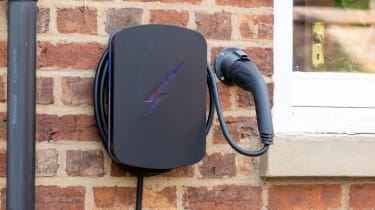
1. Hypervolt - 92.32%
It was a landslide victory for Hypervolt, after taking the first place in seven out of the nine categories in the 2023 Driver Power survey. According to everyone who took part, the installation process couldn’t be simpler and the physical units are very stylish and are very well built. Hypervolt's customer service impressed owners, too, who also said that the smartphone app for the chargers is easy to use. Taken together, awarding the Hypervolt Home 2.0 our Best Home Charger award for 2023 was a no-brainer.
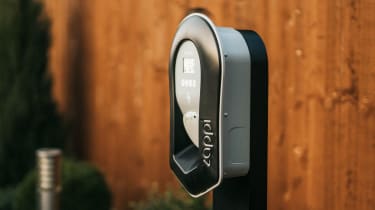
2. Zappi - 89.36%
Winner of our Best Home Charger award last year, Zappi may have missed out on the top spot in this year’s survey, but it still received a respectable set of scores across the board. The wallbox from British firm myenergi was ranked second best for build quality, charging speed and customer service. Zappi also performs well when it comes to reliability and the ease of installation.
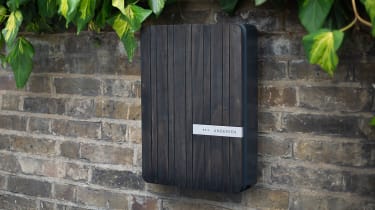
3. Andersen – 87.40%
Andersen’s chargers are up there with some of the most expensive on the market, but that’s no surprise considering the company is Porsche’s recommended charging-point provider. According to owners, the chargers are also some of the most stylish you can buy, and they also mention being equally pleased with the ease of use and build quality. However, Some owners weren’t best pleased with the speeds their chargers were providing, but otherwise there were few complaints to go around.
Best home electric-car chargers as tested by our experts
As well as listening to what real owners have to say, we have also put our experts on the job to give you their views. We have reviewed some of the newest models on the market – from the cheap and cheerful Rolec, to the minimalist EO Mini Pro. We’ve rated them in different areas, and discussed some of the different features available.
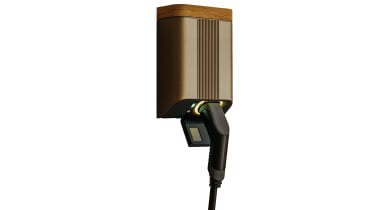
Simpson & Partners Home Series
- Price From £649
- Tethered/untethered +£50/yes
- Timer Yes
- Solar compatible Yes
- Size 286 x 196 x 111mm
- Rating 5/5 stars
Of the seven home wallbox chargers we’ve tested in 2023, the Home Series from Simpson & Partners came out on top. We have been impressed by the unit’s ease-of-use, and the overall fit-and-finish was very good, too. The tethered units can also come with incredibly long cables, ranging from 6.8m to 10m, depending on which version you go for.
The Home Series has you covered if you want to customise the charger’s looks: you can pick from a selection of finishes, and with either a metal or wooden lid. Make sure you don’t over do it, you could be looking at a four-figure price tag if you’re not careful with the options.
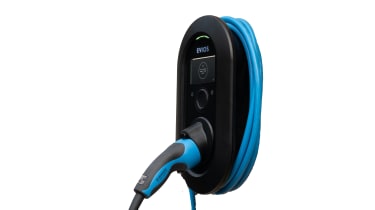
EVIOS One
- Price From £675
- Tethered/untethered Yes/no
- Timer Yes
- Solar compatible Yes
- Size 221 x 396 x 137mm
- Rating 4.5/5 stars
Style-conscious buyers may not be won over with the EVIOS One’s looks, however, if image isn’t a major concern, then it’s worth putting on your shortlist. The One is easy to use through the touchscreen controls, and the accompanying mobile app is pretty intuitive as well. Overall, you shouldn’t have problems using the EVIOS day-to-day.
The feature list on the EVIOS One is pretty generous, as well – we especially like how each user gets an individual PIN, which is handy if the wallbox will be installed in a house share or communal car park. Do be aware that the EVIOS only comes as a tethered unit – if you want a wallbox that you can plug your own cable into, you’ll need to look elsewhere.
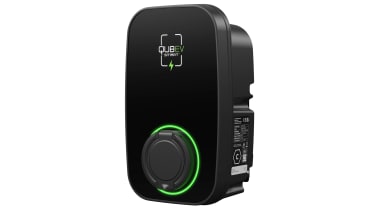
Rolec QUBEV Smart
- Price From £449
- Tethered/untethered +£30/yes
- Timer Yes
- Solar compatible Yes
- Size 200 x 330 x 109mm
- Rating 4/5 stars
Much like the plug-in hybrid and electric cars they’ll be recharging, many home wallbox units can be expensive. The good news is that there are some affordable options; one of the best we have tested would be Rolec’s QUBEV Smart.
Despite the low cost, the QUBEV is quite well-equipped, and the accompanying mobile app is also impressively useful. Like many other wallboxes, if you want a built-in cable you will need to pay a bit more, but the difference in price between an untethered and a tethered unit is only £30. If you can look beyond the unit’s size and looks, the QUBEV Smart is worth considering.
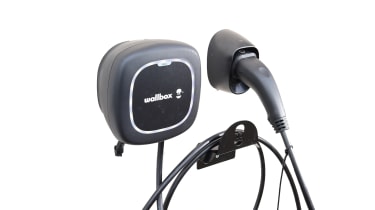
Wallbox Pulsar Max
- Price From £525
- Tethered/untethered Yes/No
- Timer Yes
- Solar compatible Yes
- Size 198 x 201 x 99mm
- Rating 4/5 stars
The Wallbox Pulsar Max shares its four-star rating with the Rolec QUBEV Smart, though it doesn’t represent quite as good value for money. However, if your budget can stretch to it, the Pulsar Max may be worth a look.
It’s much more compact than the Rolec, for instance, so the Pulsar Max makes sense if you want something a bit more discreet. The associated tech is also pretty handy – we like the Pulsar Max’s easy-to-use smartphone app, though on occasion we found discrepancies between the built-in Amazon Alexa voice controls and the LED ring which shows your car’s charging status.
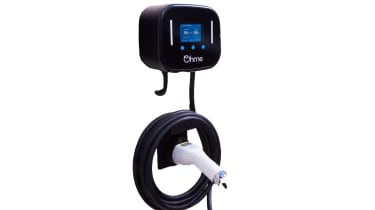
Ohme Home Pro
- Price From £560
- Tethered/untethered Yes/no
- Timer Yes
- Solar compatible No
- Size 170 x 200 x 100mm
- Rating 3.5/5 stars
If you want a really compact wallbox charger, then you may want to put the Ohme Home Pro on your shortlist. It’s admittedly a bit bigger than Ohme’s other wallbox offering, the ePod, though that one makes do without an LCD screen so we believe the Home Pro’s larger dimensions are worth it for the better functionality.
Another plus point for the Ohme Home Pro is that it’s compatible with the energy provider Octopus’ Intelligent off-peak evening charging tariff, meaning potential savings on cheaper charging rates. Like other smart home wallboxes, the Home Pro can receive over-the-air software updates, though unlike others it doesn’t connect to the Internet through WiFi – it instead uses a 3G/4G mobile data connection.
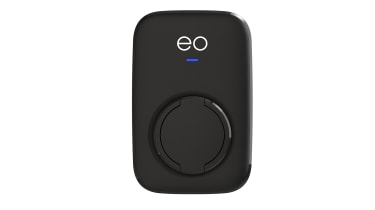
EO Mini Pro
- Price From £520
- Tethered/untethered +£40/yes
- Timer Yes
- Solar compatible Yes
- Size 230 x 151 x 125mm
- Rating 3.5/5 stars
Reasonably priced, small in size and discreetly designed, the third-generation EO Mini Pro is a compact home wallbox unit that makes a decent case for itself. It helps that the mobile app connects quickly and without fuss; you need this to operate the charger as it has no display screen or button functionality to speak of.
One concern with the EO Mini Pro is that, when compared with some similarly-priced rivals, it’s lacking in some features. For example, solar compatibility is only available on the Mini Pro as an optional extra. Due to its small size, the tethered models can only be fitted with a 5m cable, so the EO isn’t ideal if you need a long cable on your home wallbox.
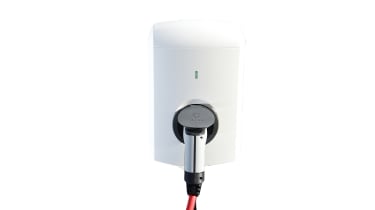
Hive Alfen Eve S-Line
- Price From £439
- Tethered/untethered +£85/yes
- Timer Yes
- Solar compatible No
- Size 240 x 370 x 130mm
- Rating 3/5 stars
For value, the Hive Alfen Eve S-Line does stack up fairly well. It’s one of the more affordable chargers in this test (though the tethered models are quite a bit pricier than the untethered ones), and the offers available through British Gas can help sweeten the deal even further. Using the Hive mobile app, you can also schedule charging for when your energy tariff is at its cheapest.
However, other chargers out there do offer a similar feature-set to the Hive, and in order to use that app you will need a mobile data connection. The Alfen Eve S-Line is also very big (it’s by far the largest wallbox in this test), which may put off those who’d prefer something that’s a bit less brash.
How do I charge an electric car at home?
So you want to know how do you charge an electric car at home? A regular three-pin plug socket will draw a maximum charge of 3kW, which is way too slow to fully charge most electric cars in a useful amount of time, even if left overnight. Some premium EV’s can take upwards of 35 hours to charge using a standard 3-pin plug. However, installing an EV wallbox charger at home will bring down charging times, making electric-car ownership considerably more viable.
What is a home wallbox charger?
A home wallbox charger is a unit that’s installed either in your garage or outside your house – whichever is more convenient to where you park your car. This is connected to your home’s mains electricity and virtually all of these devices will charge your car at a faster rate than and more safely than can be achieved using a normal three-pin plug.
There are various other benefits: you don’t need to run an extension cord from your home, which could be hazardous; wallboxes are weatherproof, so they can be used in all conditions; some units are also ‘smart’ and can be controlled remotely with an app on your phone.
What types of home wallbox chargers are there?
There are dozens of different companies offering home wallbox chargers. The factors you’ll need to consider are price, ease of installation, charging speed, connector and cable type, compatibility with your home and even how the wallbox looks. Using these considerations can help narrow down the many options to pick the wallbox that fits your needs and desires best.
In 2014, the European Commission ruled that all public charging points should feature Type 2 connector compatibility. This is why new electric cars and PHEVs often feature Type 2 plugs and cables – and why most home wallbox chargers are also intended for vehicles with Type 2 cables.
It’s also worth noting that some manufacturers have partnerships with a certain wallbox supplier, so it’s worth checking if they can fit one at your home for a discounted price as part of the deal.
You then choose whether you want a tethered or untethered wallbox. A tethered point means the wallbox comes with the charging cable attached, which plugs straight into your car. While some argue this isn’t as futureproof as a socketed wallbox, there's always the possibility of purchasing an adaptor later on.
An untethered wallbox comes with a standard plug, into which you have to run your own cable. These are often supplied with the car, but if not, can be bought from third-party suppliers for around £150. However, the benefit is that if you swap cars or new charging technology comes along, the only thing you need to change is the cable.
What speeds do they charge at?
Basic home chargers typically start at 3kW, though these are becoming less common as technology advances. Most units now reliably deliver 7kW of power, with the priciest units pushing out as much as 22kW – though you’ll need three-phase electricity to take advantage of these speeds. This isn’t common in UK homes, especially in older buildings.
Naturally, the price of the chargers goes up as you move through the power bands. A 3kW wallbox will fully charge the 40kWh battery in a standard Nissan Leaf in around 13 hours – giving you 168 miles of range overnight. A 7kW system will do the same job in roughly six hours, while 11kW or 22kW chargers slash this even further. Not all cars feature the on-board charger necessary to operate at these speeds, however.
Before you choose your wallbox, it’s worth thinking about your daily mileage and driving requirements. If you drive only a limited amount each day, bringing the car back with a healthy amount of battery remaining, you perhaps only need a 3kW charger to slowly recharge the vehicle overnight.
If you do a lot of driving, often arriving home with little charge left, and you need to use your car regularly throughout the week and at weekends, then a faster charger may be a better option. A more powerful charger may also future-proof you if you’re likely to buy an EV with a large battery in the coming years.
It’s worth noting that the maximum charging speed your house can deliver depends on the type of electricity supply it receives: most UK households have what’s known as a ‘single-phase’ connection, while larger buildings and factories tend to have more powerful ‘three-phase’ connections. Consult an electrician to advise on what to expect from your home, in case you make a mistake and end up buying a high-power wallbox that you later realise you can't make full use of.
What is the OZEV grant?
Some wallboxes qualify for the Office for Zero Emissions Vehicles' (OZEV) EV chargepoint grant, although as of April 2022 this is no longer available for most homeowners. Now, you’ll need to be living in a flat, apartment or rented property to take advantage of this offer. Do also be aware that there can be additional complications getting a charging point installed in these circumstances.
This grant is a Government subsidy to reduce the cost of home wallbox installation, covering up to 75% of the purchase price, with a maximum contribution of £350. It shouldn't be confused with the now-discontinued Plug-in Car Grant (PiCG), which offered savings on the purchase of the electric car itself.
In addition to what’s mentioned above, to be eligible for the OZEV grant, you need to meet the following points:
- You have dedicated off-street parking
- You own, lease, have on order, or use eligible electric or plug-in hybrid vehicle for work purposes
- Your plug-in vehicle was purchased after 1 October 2016
- You have not already claimed the grant for your vehicle
- By claiming the grant, you're not exceeding the limit of two OZEV-funded charge points per house
From July 2019, the criteria for the grant was updated to insist that eligible chargers must be ‘smart’: this means being able to connect to the internet to be operated remotely – using a smartphone, for instance – so that charging times can be scheduled.
A list of approved models and installers is provided on the Government's website. This is useful for two reasons: firstly, it can help prevent peaks in electricity demand, which could put a strain on local infrastructure, and secondly it'll help you charge when demand is lowest (usually overnight), saving you money.
How long does it take to install a wallbox?
Most charging-point providers will supply and install the home wallbox within a week, however periods of high demand may mean it takes longer to book a slot. Once you have booked a convenient slot, a few of the companies claim they can install the wallbox in as little as 2 hours as long as it is a standard installation with no additional work.
Many providers include the installation cost in the purchase price, with the installation done by a qualified technician. However, this isn’t always the case. Certain special circumstances may mean you’ll be charged extra for the installation, but this is unlikely. One company says that 90% of customers have their home wallbox installed free of charge, but as electric cars become the norm, this proportion is likely to gradually decrease.
Hopefully that answers all of your questions, but if there’s anything you’re unsure of, drop us a line at hello@drivingelectric.com…
